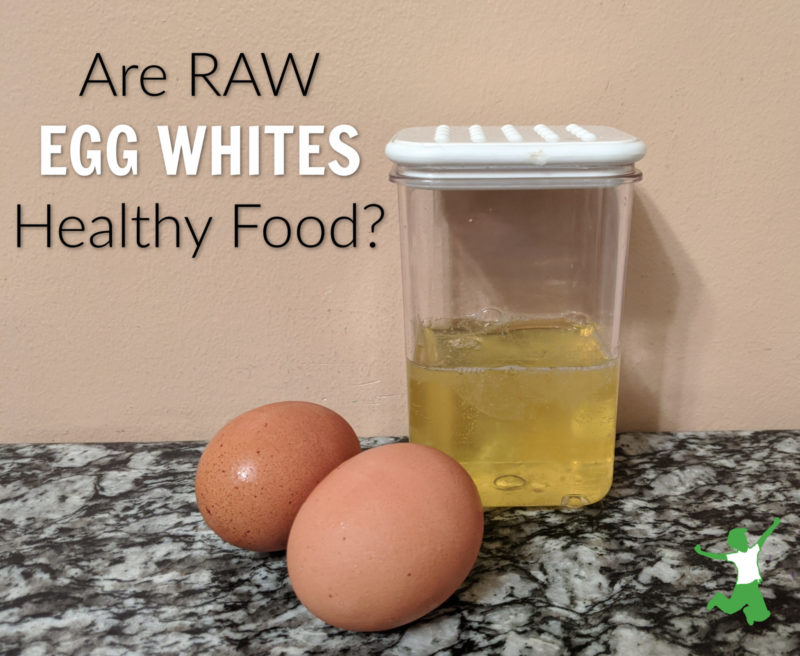Table of Contents[Hide][Show]
Why eating raw egg whites even from high-quality eggs is not a good idea despite the fact that consuming fresh, free-range yolks is a safe and healthy practice.

A common question from people who enjoy the superior nutrition of eggs on a regular basis is whether raw egg whites are safe to eat.
I posted a smoothie recipe that garnered several comments about this, so I thought I’d take a few words to answer.
Of course, I’m not talking about Egg Beaters or liquid egg whites from the store. Rather, this article is about whether the egg white from a real egg is healthy or even safe to consume without cooking.
It’s not really a matter of what is safe versus not safe … the entire egg is “safe” to eat raw if you obtain quality eggs. It is best to avoid eating commercial eggs raw due to the unsanitary conditions and crowded production methods that confined chickens are subjected to which increases salmonella risk.
The real question is whether egg whites are healthy to consume raw.
The egg yolk is a wonderful way to get healthy, unprocessed fats into the diet. Yolks from duck and goose eggs included! Loaded with enzymes along with brain-boosting and nervous system calming omega-3 fatty acids when chickens run free to peck for insects and grubs, raw egg yolks are healthy to use in smoothies, eggnog, ice cream, and other uncooked foods.
They, of course, are also healthy cooked. My favorite recipes using lots of them at once are creme brulee or traditional Welsh Rarebit.
And no, cooking egg yolks does not oxidize the cholesterol. Only the extreme heat/pressure conditions of factory processing that creates powdered eggs can do that.
What to do, then, with all the leftover egg whites if you are making a dish that requires only yolks? Can or should you use them raw?
Anti-Nutrients in Raw Egg Whites
Most people do not realize that raw egg white contains avidin and trypsin inhibitors. Duck egg whites also contain this anti-nutrient.
Avidin blocks the digestion of biotin, one of the B vitamins. The trypsin inhibitors make digestion of the protein in the egg white more difficult.
Both of these anti-nutrients are neutralized by cooking. As a result, it is best to reserve the egg whites for cooked dishes. This same rule also applies for the pinkish or reddish egg whites that backyard chicken keepers sometimes get.
Even though raw egg whites contain anti-nutrients, the amount doesn’t compare with aquafaba. This popular vegan egg substitute made from cooked chickpea water contains dangerous substances such as saponins, which contribute to the development of leaky gut according to scientific research. What’s more, the anti-nutrients won’t go away with cooking, so avoid it!
What About Whites from Fertilized Eggs?
There is information going around that raw egg whites are safe to eat if they are from fertilized eggs.
Unfortunately, this simply is not the case!
According to Sally Fallon Morell, President of the Weston A. Price Foundation, raw whites are still very hard to digest even if the egg is fertilized.
The bottom line is that no matter whether you use organic store eggs, unwashed/fertilized eggs from the farmer’s market, or those from your own hens, you should always cook the whites before eating them.
Ways to Use and Store Uncooked Egg Whites
So, if you are adding a lot of raw yolks to your smoothies, what to do with all those leftover whites?
My favorite way to use up lots of uncooked egg whites in a hurry is to make nutrient-dense, soaked waffles or delicious high protein cookies.
If you can’t use them right away, they store well in a glass container in the refrigerator for several days until you are ready to use them up.
One other salient point. The egg yolk actually contains about 43% of the protein in the egg. (source)
So don’t worry that leaving out the egg whites from your smoothies will leave it devoid of this macronutrient.
More Information








Leave a Reply